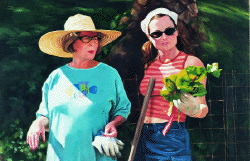Delia Brown
Margo Leavin Gallery, Los Angeles, USA
Margo Leavin Gallery, Los Angeles, USA

Built on common goals and shared (if continually shifting) values, the artist-dealer relationship is less a business arrangement than a partnership along the lines of a marriage. From the early stages of courtship, through the tentative first dates (group shows) to the consummation (first solo show) and the honeymoon (sales, favourable reviews), the artist and dealer enact an amour fou fuelled by mutual wish-fulfilment. Culminating in representation (the public declaration of commitment), their alliance, based on trust and goodwill, is never truly secure. Often, it's a power struggle fraught with jealousy (when the dealer lavishes attention on a new artist or when the artist shows in another gallery), resentment, neediness, paranoia and passive-aggressive ploys. And when things go sour, the bitter litany of sacrifices and transgressions is sung by all.
This sticky psychodrama was the script for Delia Brown's first solo show at the Margo Leavin Gallery. Already well known for her paintings depicting faux-hedonistic soirées populated by gangly model types and set in the trash-chic mise-en-scène of a Brett Easton Ellis novel, Brown's newest project casts herself as the daughter of her dealer, Ms Leavin. As the proprietor of one of LA's oldest and most respected galleries, Leavin is a wealthy, powerful art-world figure whose stamp of approval can put a young artist's career on the fast track to success. Her gallery's recent acquisition of a number of grad-school débutantes such as Brown attests to her desire to stay competitive in a fickle market increasingly fixated on fresh talent. I mention all this only because it forms an important backdrop to Brown's project, which is all too aware of these facts and of the power-brokering mechanisms at work in the contemporary art scene. Given this awareness, the project seemed to offer an unparalleled opportunity for critical self-examination, even whistle-blowing. For most artists, with the exception of Paul McCarthy in his scathing and hilarious Painter (1995), have steered clear of the back-room manoeuvrings of the commercial gallery, and most institutional critique focuses on either issues of power, history and connoisseurship as they apply to museums or on the relationship of a work's meaning to the framing device of the gallery space.
Unfortunately, Brown either ignores or does not recognize this opportunity. In place of an informed critique she presents an unabashed celebration of lifestyle as a signifier of success. Even more disturbing is the barely veiled sycophancy in which the artist engages. From her dealer, who must have been flattered by her depiction, to collectors, curators and critics, who might be amused by the unexpected novelty of Leavin's star turn, Brown tries desperately to please everyone who might conceivably be of help to her. Hermetic and overripe, the work is infused with a dank, hothouse atmosphere that could only appeal to complete insiders. If it is about desire, then it is narcissistically about the desire for art-world fame. In fact, the whole enterprise - from its half-baked concept to its shaky execution - comes off as an adolescent's anxious yearning for approval.
The easy-going reverie depicted in many of the paintings and drawings is belied by a line quality that appears forced and hesitant, and a handling of paint that is stiff and overwrought. One invariably wonders about the photographs on which the paintings were based. Shot by Ann Collier and Florian Maier-Aichen, two significant young artists in their own right, I imagined that they might reveal details - cracks in the artifice - that would allow the work to breathe.
As it is, however, the paintings are airtight and smug in their apparent self-importance. Image after image presents a privileged lotus-land where even gardening is an act of over-bearing judgement: Untitled (Appraising the Chard) (all works 2001) is just one example. Other scenes depict Brown and Leavin enjoying pool-side cocktails or lounging in the study. Even when Leavin is shown at her office desk, she is buoyant and untouchable. Nothing, one infers, could threaten this world. The three small paintings in which Brown and Leavin are shown arguing (foreshadowing future tiffs over money or control?) seem relatively inconsequential, tantrums on Brown's part met with icy calm by Leavin.
Ultimately, the roles Brown has assigned to herself and Leavin seem misconstrued. The manner in which the dealer is shown to care for the artist, in such works as The Good Mother or an untitled drawing which shows her in the bathroom gazing at Brown, who has just emerged from the shower, is less maternal than proprietary. And Brown, for her part, cannot hide the resentment her inferior position instils. Behind the smiles and tender moments, there in the rendering of her own cold eyes, one glimpses the social-climbing courtesan.














